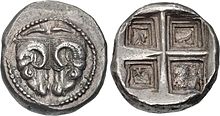Coins of Delphi
The Delphic coins were minted irregularly on behalf of Amphictyonic tribes. There were staters , Tridrachmen, drachmas , Hemidrachmen, Obole minted, Hémiobole.
Chronology of coinage
Delphi minting lasted from around 515 BC. BC to 357 BC One can divide this time into three coining periods.
First minting period approx. 500 BC Chr. – 421 BC Chr.
The first known Delphic coin originated in 515 BC. The face of the coin shows the head of a ram , a symbol of the god Apollo . On the back of a shell or is Omphalos in the carved square shown.
Soon after 479 BC BC, i.e. immediately after the Persian Wars, a tridrachm was created in Delphi. Two rhyta in the form of ram skulls are placed next to each other on the front. These drinking vessels represent valuable votive gifts that were probably consecrated in the temple at Delphi after the victory over the Persians. Two dolphins are depicted above the rhytes, they too belong to the cult of Apollo. The reverse side shows four cassettes , each with a dolphin and a palmette in each of the fields.
Between 450 and 420 BC Silver obols were minted. A tripod , the seat of the Pythia , is shown on the front . On the reverse of these coins a bowl or an omphalos in the quadratum incusum is shown again. In doing so, they follow the usual representations from the time after the Persian Wars.
Second period of issue 421 BC Chr. – 371 BC Chr.
The only known coin from this period is a stater. On the front is a representation of a ram's head and on the back a goat's head in the quadratum incusum . The goat's head is an allusion to the legend that the place for the Temple of Apollo was found by a stray goat .
Third period of coinage 371 BC Chr. – 357 BC Chr.
In 373 BC The Temple of Apollo was destroyed by some catastrophes in the 4th century BC, so the residents of Delphi had to restore the building. But the Phocians conquered the sanctuary and plundered the treasure houses. From 346 to 336 BC The treasure was partly repaid through the annual payment of the Phokers. During this time the Amphictyons decided to melt the outdated stock of silver coins in their possession and convert them into a uniform local coinage.
In 336 BC The amphictyons in Delphi minted interesting coins again under special circumstances. They are staters with an inscription that can be identified as the coinage of the Delphic Amphictyony. The obverse of the new coins depicts a Demeter head , crowned and veiled with ears of wheat. The back is dedicated to Apollo. Two motifs were chosen for the back. On some of them, Apollon Phytias is shown sitting on the omphalos with a laurel branch in his hand and an oversized lyre , in front of him is the sacred tripod. A legend "AMΦIKTIONΩN" is reproduced around the coin. On other coins there is a snake wound around the omphalos, this snake is a python .
particularities
Of all known Delphic coins, the aiginetic tridrachm has several peculiarities. This coin is much heavier than normal tridrachms. The weight is just as high as the Aiginetic drachms, but they are heavier than Attic tetradrachms.
literature
- Barclay V. Head : Catalog of Greek coins. Central Greece . British Museum, London 1884 (reprinted Bologna 1963), pp. XXIX – XXXIV.
- Peter R. Franke , Max Hirmer : The Greek coin . Hirmer, Munich 1964, pp. 102-103.
- Colin M. Kraay : Archaic and Classical Greek coins . Durst, Sanford 1983, pp. 121-124.
- Michael Maaß : Ancient Delphi . Munich 2007, pp. 1-45.
Web links
- Widderkopf – Hemiobol in the interactive catalog of the Münzkabinett Berlin
- Two drinking horns in the shape of a ram skull tridrachm in the interactive catalog of the Münzkabinett Berlin
- Dreifuß-Obol in the interactive catalog of the Münzkabinett Berlin
- Head of Demeter with wreath of ears in the interactive catalog of the Münzkabinett Berlin
Individual evidence
- ^ Colin M. Kraay: Archaic and Classical Greek coins . Durst, Sanford 1983, pp. 121-124.
- ^ Barclay V. Head: Catalog of Greek coins. Central Greece . London 1884, pp. XXIX – XXXIV.
- ^ Colin M. Kraay: Archaic and Classical Greek coins . Durst, Sanford 1983, pp. 121-124.
- ^ Peter R. Franke, Max Hirmer: The Greek coins. Munich 1964, pp. 102-103.
- ↑ »www.smb.museum«
- ↑ Michael Maaß: The ancient Delphi. Munich 2007, p. 145.
- ^ Barclay V. Head: Catalog of Greek coins. Central Greece . London 1884, pp. XXIX-XXXIV.
- ^ Colin M. Kraay: Archaic and Classical Greek coins . Durst, Sanford 1983, pp. 121-124.
- ^ Peter R. Franke, Max Hirmer: The Greek coins. Munich 1964, pp. 102-103.
- ^ Colin M. Kraay: Archaic and Classical Greek coins . Durst, Sanford 1983, pp. 121-124.


